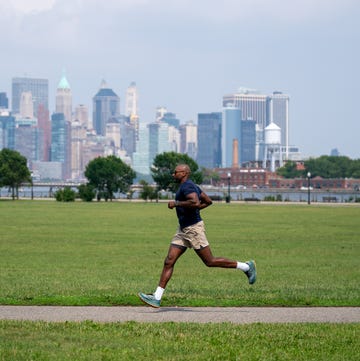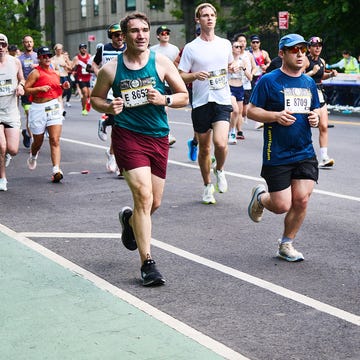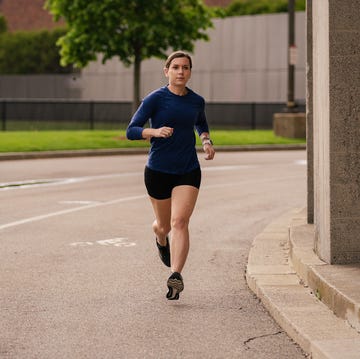Have you been feeling as though your run paces have plateaued? Maybe when you first started running, you saw progression from 12-minute miles down to 10-minute miles within a few months, just by being consistent and putting in the miles.
But at some point, you may have noticed that your everyday pace—the pace you run when you’re not really thinking about a pace—has flattened. You’re fitter than ever, but your paces are stuck where they were a few years ago. What’s causing the block: Is it your head, your lungs, or your legs?
To hit faster speeds, especially if your goal is longer races like half-marathons and marathons, working on boosting on your endurance pace/everyday pace can be the key to your long race success.
For most runners, the “easy pace” you run when you’re just doing regular mileage (not a quality workout), is somewhere in between high zone 1 or low zone 2 effort, explains high-performance run coach and researcher Sasha Gollish, Ph.D. It’s easy to get stuck in a rut in this pace, considering it’s the run pace we do when we don’t want to push hard, when we just want to feel calm and steady. It’s not quite as easy as jogging or an all-day pace, though—you’re still working, just not very hard. And it can keep you stuck in a speed rut.
So we asked two high-level run coaches to offer their best advice for pinpointing what’s holding you back from reaching faster speeds, plus how to remedy the rut.
5 Questions to Ask to Get Out of a Pace Plateau
1. How does your “everyday pace” actually feel, if you’re being honest?
If you’re barely able to wheeze out a sentence, you may be pushing too hard in your everyday runs, and that extra effort is ironically slowing you down in the long run. Hitting the right endurance pace allows you to improve your aerobic system, and that allows you to get faster as you move into tempo and threshold efforts.
2. How long have you been stuck at this pace?
If it’s only been a few months since you saw progress, that’s normal… especially once you’ve been running regularly for a few years, says Alex Ullman, the cross-country coach at the University of Waterloo and a former collegiate runner.
Gains become more and more incremental as you get fitter, which may feel unfair as you see new runners around you making huge strides and dropping their paces by 30 seconds a mile every couple months.
However, if you’ve been stuck in your pace for a year or two despite following a training plan, you may need to tweak an aspect of your training.
3. Are there any factors that could be affecting your pace?
This could be environmental. For example, if you’ve only noticed this plateau in the heat of summer, you may want to curb your panic until temps cool off in the fall, considering the heat can depress your pacing by making your run feel harder, says Gollish.
If you’re coming back from an injury, it may take months after you stop noticing that niggle in your knee to get back to your faster paces.
And age does play a role as well: Too often, Gollish notes, we’re trying to compete with our past selves and hold onto paces that made sense 20 years ago. Yes, it’s possible to actually make progress in your running in your 60s, but if you’ve been running for decades, you may need to meter your expectations.
4. Do you feel like your barrier is mental or physical?
“There are physical aspects that may be holding you back: Poor running form can slow you down and keep you stuck. There is not a perfect ‘one size fits all’ run form, but if you’re twisting around and slamming into the ground and wasting energy, you are going to see massive gains from working on your stride,” says Gollish. “But I do think a lot of us get stuck at a certain pace because we mentally have limited ourselves. If you’ve got a beautiful stride but you’re constantly stuck in your head, you need to have a check in with yourself as to where that block is coming from.”
5. Finally, are you running by pace, by feel, or by heart rate?
None of these metrics are bad, but each can cause you to get stuck in a rut if you’re too caught up in it, says Ullman. Depending on which you tend to lean on, there are different strategies you can use to bust out of your rut.
Why Your Go-To Metric Could Be Working Against You
Most runners have a metric that they rely on—pace, heart rate, or feeling (rate of perceived exertion). Focus on any one metric can get you stuck in a rut, if you never consider how all of these factors work together.
For example, you may be focusing on hitting a certain pace for those endurance miles, but as you’ve gained fitness, you’re actually running at a much lower heart rate at that pace that used to take more effort.
Here’s how each metric may be making you slower.
Pace
If your training plan, run club, or coach gives you paces to stick to for every run, you don’t get the chance to explore how other speeds feel, making it impossible to find that sweet spot. “I think too often, coaches are overly prescriptive with paces, and we limit people without exploring what their potential is,” says Gollish. Ultimately, the runner ends up developing a muscle memory for that particular pace because they’re so used to hitting it, and going just a little faster feels much harder than it should.
You also may be hindering yourself by being too pace-obsessed during the run, staring at your watch instead of at the road ahead. “Runners who are glued to their watch, looking at their pace all the time, are going to struggle,” Ullman adds. “Many runners are tied to a pace to the point where, after they’re done the workout, they base whether they had a good workout or bad workout entirely on if they hit the paces or not—they don’t think about how the workout felt at all.”
Heart Rate
There’s a reason we use heart rate zones rather than heart rate. Each zone has a range to it, but many runners find themselves looking for one specific number somewhere within that zone.
Here are the heart rate zones, calculated based on your max heart rate (MHR), according to the National Academy of Sports Medicine (NASM).
- Zone 1 (very light effort) = less than 57% of your MHR
- Zone 2 (light effort) = 57-63% of your MHR
- Zone 3 (moderate effort) = 64-76% of your MHR
- Zone 4 (vigorous effort) = 77-95% of your MHR
- Zone 5 (maximum effort) = greater than 95% of your MHR
So if you’re training in zone 2 with a max heart rate of 185, your heart rate could be anywhere between 106 and 117 bpm. And you should be moving around in that zone.
“If you’re feeling really good and well-recovered, you can push to the top of a heart rate zone,” says Gollish. “If you’re tired, then aim to stay at the bottom.” But don’t be afraid to let your heart rate go up and down in that range throughout the run. Sticking to 106 bpm may keep you running too easy, while always pushing to 117 bpm may leave you under-recovered if you’re having a bad day.
Perceived Exertion
Rate of perceived exertion (RPE) simply refers to how hard you feel like you’re working. Typically measured on a scale of 1 to 10, with 10 being all-out effort, it’s arguably the most important metric. But it is one that can trick you into staying stuck if you never cross-reference it with heart rate or pace.
You may actually have improved your fitness significantly and should be pushing your pace a bit faster, but that muscle memory of endurance pace keeps you stuck and unwilling to push.
“One of the challenges with all of this technology—run watches and wearables and heart rate monitors—is we’ve lost that ability to actually be able to feel,” says Gollish. “So I do think perceived exertion is really important. But sometimes you do need to see how it matches up with the data, because there are so many factors that can impact perceived exertion.”
How to Actually Drop Seconds Off Your Pace
Unstick Your Brain
“If you’re an experienced runner who has been stuck for a year or two at the same pace, your brain is stuck on that pace,” says Ullman. “You need to get out of the mental holding pattern that you’re in.”
To do this, Ullman turns to interval workouts and pushes athletes to experiment with new paces. “I like getting runners to do a few different paces during interval workouts to try to get them used to different feelings,” he says. For example, if you’re doing mile repeats, Ullman would set one of them faster than your usual goal pace, one slower, and one at goal pace. Often, runners realize that they can actually hit that faster pace with no problems, he says. The slower pace interval also allows them to release the idea of the “perfect workout” where every interval is right on target.
Stop Looking at Your Watch
If you’re always looking down at your watch to check your pace or look at your heart rate, cover that watch face with electrical tape and get used to doing your run analog-style by basing your pace on feel.
“Just start slow and then pay attention to your body signals,” says Ullman. “Toward the end of your run, start pushing your boundaries by picking up the speed just a little bit. The more you work on this, the more you’ll adapt to learning how to run by feel and understand when you can push your boundaries. And you may be surprised at how varied your pace gets when you stop concentrating on the number on the screen!”
Sure, you may have one mile that’s a bit slower—but you’re just as likely to have a speedier mile in the mix as well. Being able to shift speeds rather than stick to an exact pace also lets you speed up after a slower-than-preferred aid station without panicking in your next race.
Sneak Up the Speed Slowly
The catch to getting faster on the run is that it’s not always comfortable. You’re likely stuck in your rut because your current pace feels good, and getting even a few seconds faster is going to mean some discomfort. That’s why Gollish recommends tricking your body by starting your runs at that comfortable pace that you’re used to, and then gradually dialing up the speed by just a couple seconds per mile at a time throughout the course of your run.
For example, if you normally run 8:40s and you’re doing a 10-mile run, start at your normal pace but aim to get down to 8:20s by the end. “If you start the run by trying to go at an 8:20 pace, it’s going to feel hard right off the bat,” says Gollish. “Not only is your body going to rebel and feel more fatigued, your brain is going to start stressing out right away.”
Gollish also recommends starting your run at your comfortable current pace, then drop it slightly (by a few seconds) for the middle of the run, and then in the last mile, drop it down to a pace that’s about five percent faster than your current easy pace. If you’re normally an 8:40 runner who wants to speed up, that means doing your last mile in the 8:00 to 8:10 range.
Play in Your Zone
As we mentioned earlier, your heart rate goal should be within a range, not one specific number. You’re likely attached to one specific heart rate that feels comfortable—but if it’s not at the top of the heart rate zone you’re training in, you have room to play. “That’s the only way you’re going to improve—pushing your boundaries,” says Ullman. “And honestly, you learn so much about yourself when you do push a bit.”
Expect to Fail
This is going to be a learning process. “A lot of people get discouraged when they do a run and try to increase pace slightly halfway through, but then realize in that last mile that they pushed it way too fast,” says Ullman. “But what happened there is that you learned that you can’t hold that faster pace. Maybe you can hold a slightly slower pace the next time, though. Don’t get discouraged, use it as information, and next week, you can do a similar workout and know where your boundaries are.”
Be Ready to Up Your Fueling
Going faster? You may need to fuel more, considering you’ll be working a little harder as you adapt to a speedier pace. “Dropping from an 8:30 pace to an 8:10 pace may mean that you’re engaging your different energy systems slightly differently,” says Gollish. “Anytime you’re trying to progress your running, your fueling has to adjust to accommodate it.” She suggests increasing your carb intake by a few extra grams per hour when your run is over 60 minutes.
Look for Small Wins
It’s tempting to decide that by the end of the month, you’ll have dropped your pace by 15 seconds per mile. But it’s going to take time, so celebrate the small wins to get to the big adjustments.
“Even the difference between 8:30 and 8:28 is significant—that’s almost a minute off of your marathon time,” says Gollish. “I think too often we talk about making these big jumps, but these small wins come easier and do add up eventually.”
Unfortunately, there’s no definitive drop in pace you should expect after a certain number of weeks. It’s so individual, says Gollish, and you may already be close to your peak pace, while your training partner could see a 20 second drop after two months.
Take Other Factors Into Account
As you work toward these faster paces, remember that lack of sleep, fatigue, weather, and terrain can all affect your pace. If it’s 100 degrees out, you may be slower than normal even if you have been making progress toward dropping seconds off of your average, says Ullman. Or if you’re doing any kind of trail running or hill work, your pace will definitely change with the terrain.
Gollish notes that there are intangibles, including life stress—a fight at work, an issue with your teenager—that can also slow you down. “You may find that if you run first thing in the morning and you feel fresh and great, 8:30s are super chill and relaxed and fantastic. But if you do that at the end of a really stressful day, it can be really taxing,” she says. “You need to be able to back off and accept the pace that feels right in that moment.” So don’t get discouraged if your new, slightly speedier pace isn’t there on every single run.

Molly writes about cycling, nutrition and training with an emphasis on bringing more women into sport. She's the author of nine books including the Shred Girls series and is the founder of Strong Girl Publishing. She co-hosts The Consummate Athlete Podcast and spends most of her free time biking and running on trails, occasionally joined by her mini-dachshund.


















